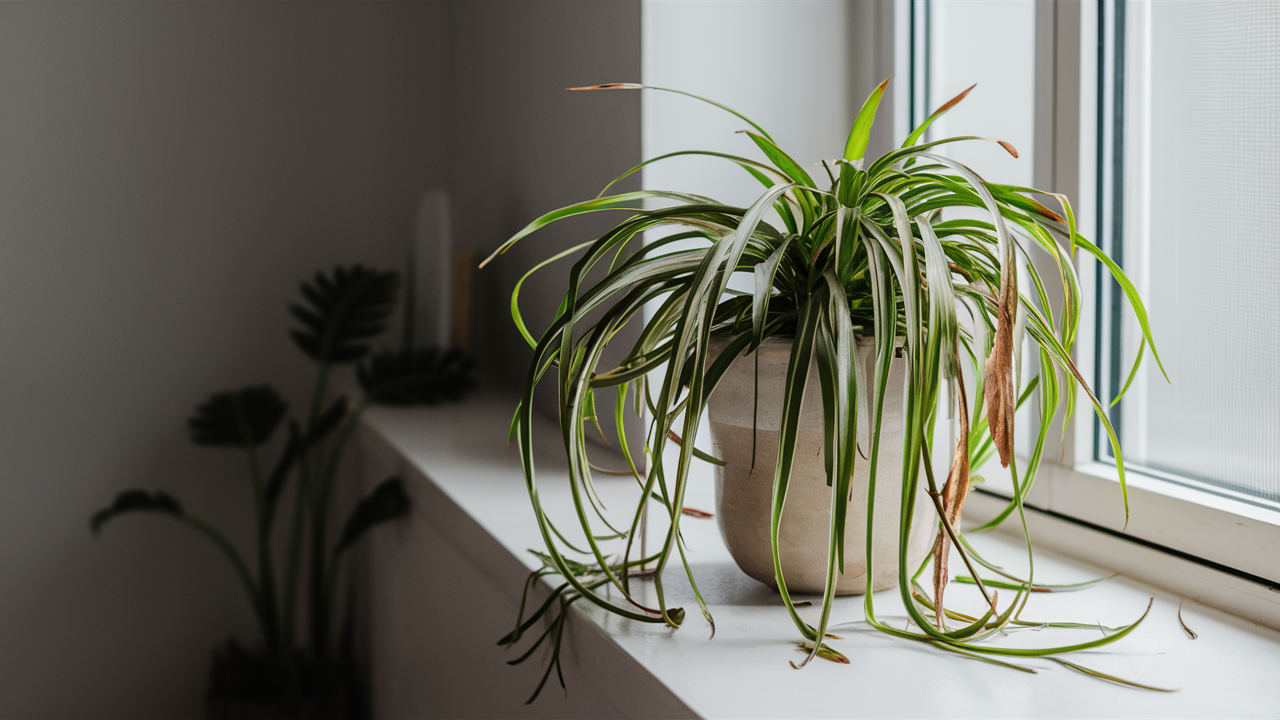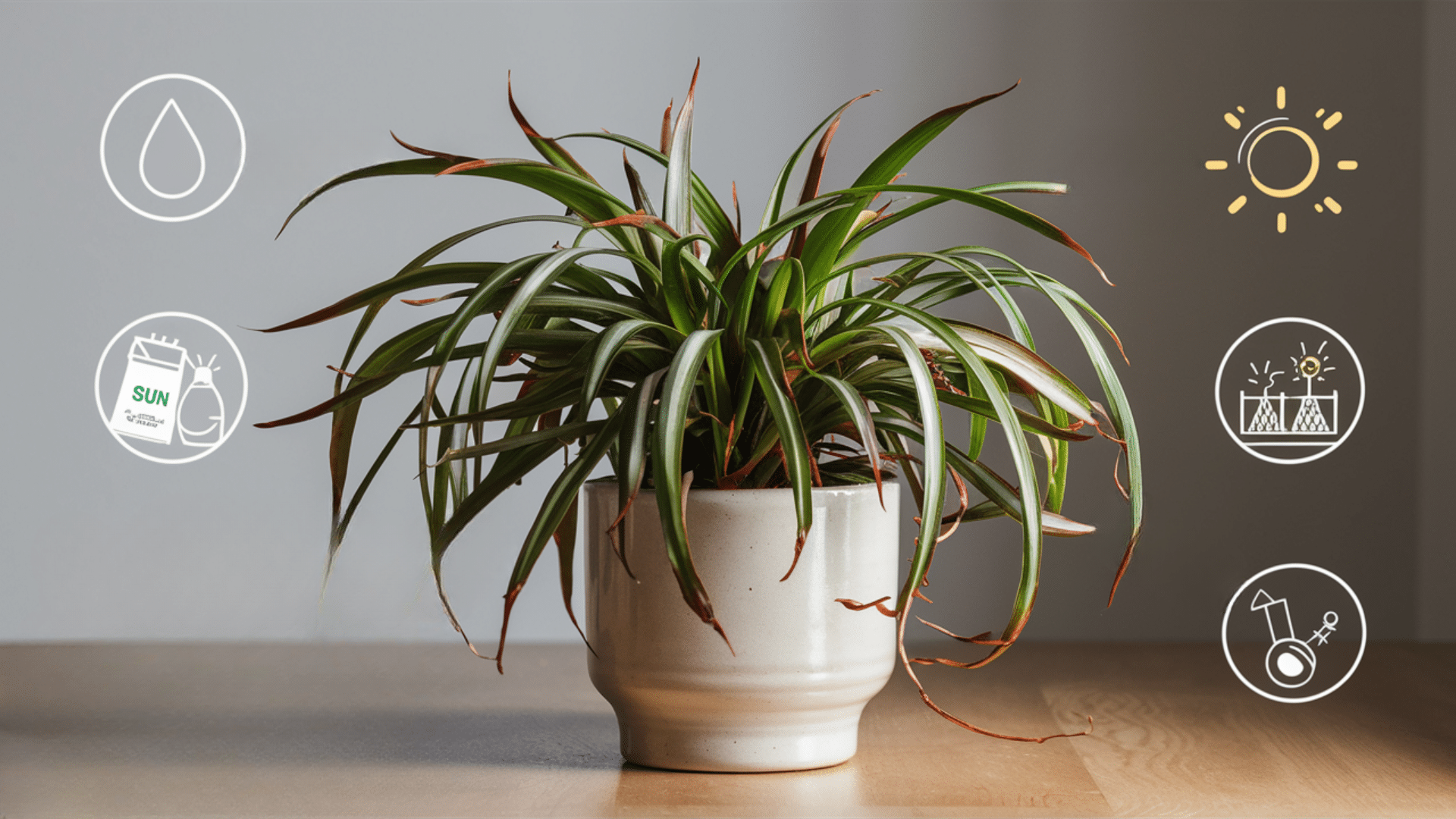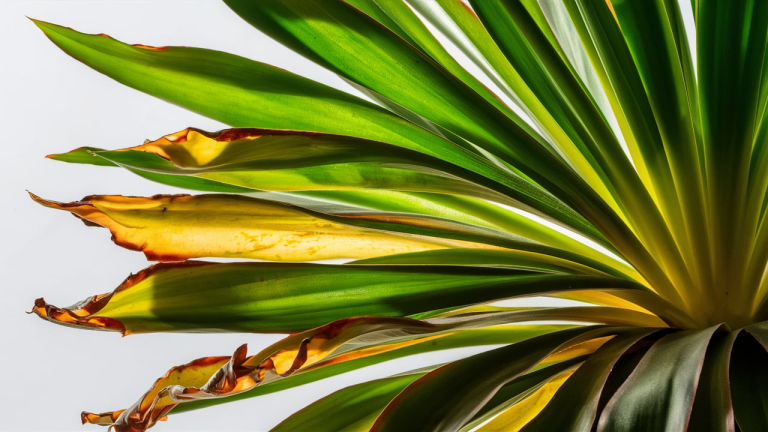Those brown tips on your spider plant got you worried? I get it. I’ve spent years growing these plants and still deal with crispy tips now and then.
In this guide, I’ll show you exactly:
- What causes those annoying brown tips (7 specific reasons)
- Step-by-step fixes that actually work
- A simple care routine to keep your plant healthy
- When to start fresh with a new plant
I’ve tested these solutions on dozens of spider plants, both my own and those belonging to friends who bring their plant problems to me. No complicated gardening terms or expensive products needed.
Brown tips don’t mean your plant is dying. With a few simple changes, you’ll see healthier growth and fewer brown edges. Let me help you turn those crispy tips back to green, beautiful leaves your plant was meant to have.
What Do Brown Tips Actually Mean?

Brown tips on your spider plant are simply a sign that something in its growing conditions isn’t quite right. Your plant is trying to tell you something. The good news? Spider plants are tough, and brown tips rarely mean your plant is dying. Think of them as an early warning system – your plant providing you with feedback before more significant problems arise.
Brown tips typically start with a small, yellowing area that later develops into a brown, crispy texture. The browning normally stays at the tips rather than spreading through the whole leaf.
Reasons Spider Plants Get Brown Tips

Tap Water Chemicals (Fluoride, Chlorine)
Spider plants are sensitive to chemicals in tap water. The fluoride and chlorine that make our water safe for us can accumulate in the soil and damage plant tips. This happens because spider plants store these chemicals in their leaf tips, which eventually causes the leaf tips to burn and turn brown.
How to tell if this is your problem: If you notice brown tips developing shortly after watering with tap water, especially if you live in an area with heavily treated water, this is likely your culprit. The browning pattern tends to be very even across multiple leaves.
Underwatering or Inconsistent Watering
When a spider plant gets too dry or experiences big swings between soaking and bone-dry soil, its leaf tips often turn brown in protest. Spider plants prefer soil that dries out slightly between waterings, but not completely.
Signs to watch for: Soil pulling away from the sides of the pot, drooping leaves that perk up after watering, and a lightweight pot are all signs your plant is too dry. If you notice brown tips appearing after the soil has been completely dry for days, inconsistent watering is probably the cause.
Too Much Fertilizer
Over-fertilizing can create a buildup of salts in the soil, which can burn the tips of your plant’s leaves. Spider plants need much less food than you might think! They’re not heavy feeders and can thrive with minimal fertilizer.
How fertilizer burn looks: Brown tips from fertilizer often appear crusty with a yellowish edge before turning brown. You may also notice a white crust on the soil surface or the pot edges. If you’ve been following standard fertilizing instructions for most houseplants, you’re probably giving your spider plant too much.
Low Humidity
Spider plants prefer higher humidity levels than most homes typically provide. When the air is too dry, the leaf tips can dry out and turn brown. This is especially common during winter when heating systems dry out indoor air, or in naturally arid climates.
Humidity clues: If your plant’s brown tips coincide with seasonal changes or the use of heaters or air conditioners, low humidity is likely the cause. The tips may also feel particularly crispy and brittle compared to other causes of brown tips.
Too Much Direct Sunlight
While spider plants need bright light, direct sun can scorch their leaves, causing brown tips and patches. Unlike some houseplants, spider plants have somewhat delicate leaves that can burn easily in harsh afternoon sunlight.
Sunburn signs: Look for brown spots or patches appearing on leaves facing the window. Sun damage often creates more irregular browning patterns than other causes, and may affect the whole leaf surface, not just the tips. You may also notice the green color fading to yellow before it browns.
Pot-Bound Roots
Spider plants actually like being somewhat root-bound, but when they get extremely crowded, it can stress the plant and cause brown tips. This happens because the roots can’t access enough water and nutrients when they’re too cramped.
How to check: If your plant hasn’t been repotted in two years or more, has roots growing out of the drainage holes, or pops up out of the soil when watered, it’s likely too root-bound. When this is the case, you’ll often notice slower growth and many brown tips appearing simultaneously.
Leaf Age
Sometimes the oldest leaves just naturally brown as part of their life cycle. This is a normal part of aging and nothing to worry about. Just like humans, spider plants’ oldest leaves eventually turn brown and die off.
Natural aging looks like: The oldest, outermost leaves turning brown first, while newer growth stays healthy. If only the oldest few leaves have brown tips while your newer growth looks perfect, you’re probably just seeing the natural aging process at work.
Spider Plant: What You Shouldn’t Do First
When you spot brown tips, your first instinct might be to:
- Dump in more water – This often makes things worse!
- Add more fertilizer – Usually the opposite of what’s needed
- Move it to a dark spot – Less light isn’t the answer
- Trim off half the leaf – Only trim the brown parts
I’ve made all these mistakes before. What I’ve learned is that observation comes first. Check the soil moisture, examine the light conditions, and consider your watering and fertilizing habits before taking action.
How to Fix Brown Tips of Spider Plant
Here’s what actually works to fix those brown tips:
- Switch to filtered water or rainwater: Let tap water sit out overnight to allow chlorine to evaporate, or, even better, use rainwater or filtered water.
- Create a consistent watering schedule: Wait until the top inch of soil feels dry before watering again. Water thoroughly until it drains out the bottom, then wait for that top inch to dry again.
- Cut back on fertilizer: Feed your spider plant only once every 2-3 months during the growing season with fertilizer at half the recommended strength.
- Boost humidity: Group plants together, use a pebble tray with water, or put a small humidifier nearby. Even misting helps a bit.
- Find the right light spot: Bright, indirect light is best – near a window with a sheer curtain is perfect.
- Repot when needed: If your plant is very root-bound (roots growing out of the drainage hole or circling the pot), move it to a pot 1-2 inches larger.
- Trim the brown tips: Use clean scissors to trim just the brown parts, following the natural shape of the leaf.
Can You Prevent Spider Plant’s Brown Tips?
I’ll be honest, probably not. Even expert growers sometimes get brown tips on their spider plants. These plants are somewhat finicky about water quality and environmental conditions.
My oldest spider plant still occasionally develops brown tips, especially in winter when my home’s heating system dries the air. That’s okay! A few brown tips don’t mean you’re a failing plant parent.
The goal isn’t perfection but keeping your plant mostly healthy and happy.
Spider Plant TLC Routine
A simple care routine can help minimize those brown tips:
| Frequency | Care Tasks |
|---|---|
| Weekly |
|
| Monthly |
|
| Seasonal |
|
Following this simple schedule will help keep your spider plant healthy and minimize those annoying brown tips. The most important part is consistency – your plant will appreciate regular care even if you miss a week now and then.
When to Let Go: Replace, Repot, or Restart
Sometimes you need to make bigger changes:
- If more than 30% of the plant has brown tips, consider starting over with baby plants (the “spiderettes”)
- If the center of the plant appears healthy but the outer leaves are brown, cut away the damaged parts, repot, and provide it with fresh soil and a new start.
- If the plant is extremely root-bound with mostly brown leaves, take some healthy spiderettes, root them in water, and start fresh plants.
The good news? Spider plants produce numerous offspring, allowing you to root new plants easily. Sometimes, starting over is simpler than trying to revive a struggling parent plant.
Conclusion
Brown tips don’t mean you’re a bad plant parent. Even with perfect care, spider plants sometimes get crispy edges. The key is making small adjustments that add up to bigger results.
I’ve found that switching to filtered water and maintaining a consistent watering routine can help resolve most brown tip issues. When you see new growth staying green, you’re on the right track!
Remember that spider plants are tough. They can handle a few imperfections and still thrive. Focus on progress, not perfection.
Check your plant weekly, adjust as needed, and be patient. Your spider plant will reward you with fresh green growth, baby plants, and years of enjoyment – even if a few tips still turn brown occasionally.













